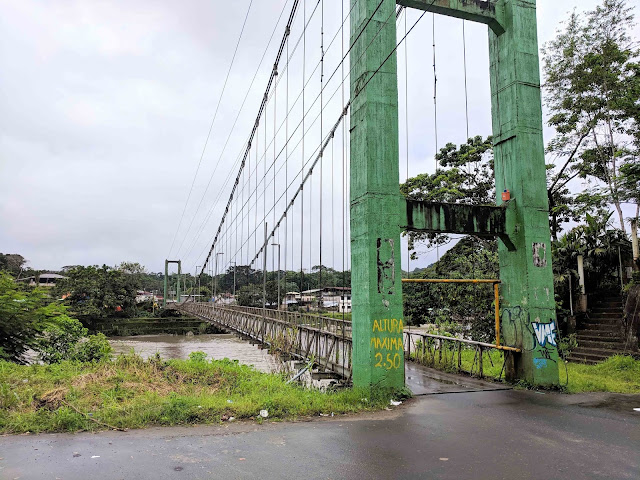Day 5 was a serendipitous surprise.
It was a Global Big Day, a specific day of the year when birders all over the world try to see as many birds as possible in a 24 hour period. Individuals, states, provinces and countries compete for bragging rights to the most birds recorded. Nicole and I had plans to join a group in Puyo, but with our late arrival and the additional distance required to meet up with them, we had to cancel. Early in the morning we stepped out of our room onto the empty road and began looking at birds.We turned to our right, and a few hundred feet down the road we spied a group with binoculars trained on trees and they were wearing Global Big Day t-shirts! Quickly we approached them and introduced ourselves. They welcomed us to join them for what turned into 13 hours of birding!
We took a boat ride around Laguna Paikawe, hiked thru the jungle and nearby farms, used bridges to look for water birds, hiked thru shallow rivers and stood beneath a massive kapok tree, the largest tree in the Amazon rainforest.
On our boat ride at Laguna Paikawe, we saw many different species. My favorite from the water was the Hoatzin, aka jungle turkey. This reddish-brown bird is about 2ft tall with a spiky orange mohawk and blue skin on its face. It's startling how large it is when you see it up close.
Orange-backed Troupial (above) Greater Ani (below)
We saw three species of monkeys- Squirrel monkeys, tamarinds and white-faced capucchin.
Masked Crimson Tanager
Great Potoo (below) was a super cool sighting. This bird is hard to locate because they hold still and look like a limb.
The kapok trees here are incredible, growing up to 200ft tall and 11 feet in diameter!


Check out the enormous root Yaku is standing behind! It's almost as tall as he is.
Taking a break before hiking thru a farm (below).
White-eared Jacamar
We did scare off one snake, came across a jaguar track, discovered a fruit bat in a hut, and found a kinkajou resting in a tree.
Gray-headed Kite eating a caterpillar. (below)
The bridge was a great vantage point for spotting water birds in Rio Napo, however its narrowness meant every time a vehicle approached we needed to scramble off the bridge. I was amazed that trucks were not scraping both sides of the bridge on their way across.
The group we were with was so knowledgeable, and not just about identifying birds and knowing where to find them. They taught us many interesting things about plants and creatures found in the jungle. There is always so much we can learn from others. It seems like a rain jacket would be helpful in the rainforest, right? Well, it's not. They explained the heat and humidity just makes you sweat inside the jacket. It's better to enjoy the refreshing rain and clothing tends to dry out pretty quickly. Of course they were right. We ended up soaked twice, and both times our clothes dried quickly. They did grab banana leaves for us to shield the rain from our faces. The waterproof bag for our cameras was essential.
This is a cacao seed. They grow inside a large red pod. You eat the fuzzy, kind of slimy white covering of the seed and save the seed to make chocolate. I tasted it raw and it was very bitter.
Unfortunately there was a wasp nest near a hut where we decided to rest. I think everyone noticed but me. I set my banana leaf down too close and they attacked. I was stung three times before I even realized what had hit me. I did not make that mistake again, and watched nervously while others sat near them without fear. They understand their behavior and know how to not trigger them. I preferred to keep my distance.
Isn't this spider fantastic?! I just happened to notice him along our jungle hike.
I later panicked when I felt something land on my arm. I was relieved when I looked down and saw this 3 inch long grasshopper. Pretty cool!
When we arrived back we found this giant Cane Toad hanging out next to our room. So big!
Here's a picture of the entrance to our room. From the road, a board crosses the ditch then a raised path leads thru the water to our door. If you missed reading about our arrival, find it HERE.


Our room is on the laguna. This is the view behind our room. Laguna Paikawe offers guided boat rides and night hikes thru the jungle. I highly recommend doing both!
I enjoyed our simple stay at Laguna Paikawe. The location is ideal. It's a short walk to the bridge and the port town of Misahuallí. We ate dinner there for a couple dollars each night. One night we stopped at a shop to pick up an ice cream bar from a freezer and noticed two naked boys next to us (about 5 and 8yrs old). It was surprising until I saw their adults were wearing the traditional Waodani attire, which for women, is a thick multi-string necklace and a type of skirt.
Mischievous capuchin monkeys are fun to watch at puerto Misahuallí.



































No comments:
Post a Comment